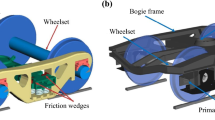Abstract
Wheel/rail relationship is a fundamental problem of railway system. Wear of wheel profiles has great effect on vehicle performance. Thus, it is important not just for the analysis of wear characteristics but for its prediction. Actual wheel profiles of the high-speed trains on service were measured in the high-speed line and the wear characteristics were analyzed which came to the following results. The wear location was centralized from −15 mm to 25 mm. The maximum wear value appeared at the area of 5 mm from tread center far from wheel flange and it was less than 1.5 mm. Then, wheel wear was fitted to get the polynomial functions on different locations and operation mileages. A binary numerical prediction model was raised to predict wheel wear. The prediction model was proved by vehicle system dynamics and wheel/rail contact geometry. The results show that the prediction model can reflect wear characteristics of measured profiles and vehicle performances.
Similar content being viewed by others
References
ZHANG Wei-hua, SHEN Zhi-yun, ZENG Jing. Study on dynamics of coupled systems in high-speed trains [J]. Vehicle System Dynamics, 2013, 51(7): 966–1016.
XU Hong, YUAN Hua, WANG Ling, NA Wen-bo, XU Wen-bin, LI Yun-tang. Modeling of metro wheel wear and optimization of the wheel re-profiling strategy based on Gaussian processes [J]. Jounal of Mechanical Engineering, 2010, 46(24): 89–95. (in Chinese)
LI Xia, JIN Xue-song, WEN Ze-feng, CUI Da-bin, ZHANG Wei-hua. A new integrated model to predict wheel profile evolution due to wear [J]. Wear, 2011, 271(1): 227–237.
POMBO J, AMBRÓSIO J, PEREIRA M, LEWIS R, DWYER R, ARIAUDO C, KUKA N. A railway wheel wear prediction tool based on a multibody software [J]. Journal of Theoretical and Applied Mechanics, 2010, 48(3): 751–770.
IGNESTI M, INNOCENTI A, MARINI L, MELI E, RIND A. Development of a model for the simultaneous analysis of wheel and rail wear in railway systems [J]. Multibody System Dynamics, 2014, 31(2): 191–240.
IGNESTI M, MARINI L, MELI E, RINDI A. Development of a model for the prediction of wheel and rail wear in the railway field [J]. Journal of Computational and Nonlinear Dynamics, 2012, 7(4): 041004.
LUO Ren, ZENG Jing, WU Ping-bo. Simulation and analysis of wheel out-of-roundness wear of high-speed train [J]. Journal of the China Railway Society, 2010, 32(5): 30–35. (in Chinese)
LI Wei-gang. Simulation-based multi-objective optimization for roll shifting strategy in hot strip mill [J]. Journal of Central South University, 2013, 20(5): 1226–1234.
ZHANG Jian, PENG Yan, LIU Hong-min, LIU Yun-fei. Establishment of wear model and life prediction of drum of hot rolling coiler [J]. Journal of Central South University of Technology, 2011, 18(6): 1808–1812.
YOON Moon-Young, BAEK Seung-Hwan, BOO Kwang-Suk, KIM Heung-Seob. Map-based control method for vehicle stability enhancement [J]. Journal of Central South University, 2015, 22(1): 114–120.
HAN Peng, ZHANG Wei-hua. A new binary heel wear prediction model based on statistical method and the demonstration [J]. Wear, 2015, 324-325(1): 90–99.
JENDEL T. Prediction of wheel profile wear—Comparisons with field measurements [J]. Wear, 2002, 253(1): 89–99.
TASSINI N, QUOST X, LEWIS R, DWYER-JOYCE R, ARIAUDO C, KUKA N. A numerical model of twin disc test arrangement for the evaluation of railway wheel wear prediction methods [J]. Wear, 2010, 268(5): 660–667.
BRAGHIN F, LEWIS R, DWYER-JOYCE R, BRUNI S. A mathematical model to predict railway wheel profile evolution due to wear [J]. Wear, 2006, 261(11): 1253–1264.
ARIZON J, VERLINDEN O, DEHOMBREUX P. Prediction of wheel wear in urban railway transport: comparison of existing models [J]. Vehicle System Dynamics, 2007, 45(9): 849–866.
ASADI A, BROWN M. Rail vehicle wheel wear prediction: a comparison between analytical and experimental approaches [J]. Vehicle System Dynamics, 2008, 46(6): 541–549.
HAN Peng, ZHANG Wei-hua, LI Yan, HUANG Guan-hua. Influence of wheelset wear and wheel radius difference on dynamics performances of high-speed train [J]. Journal of Traffic and Transportation Engineering. 2013, 13(6): 48–53. (in Chinese)
Author information
Authors and Affiliations
Corresponding author
Additional information
Foundation item: Project(U1234208) supported by the Major Program of the National Natural Science Foundation of China;Project(2013J008-A)supported by the Research and Development Plan of Major Tasks in Science and Technology China Railways Co. Ltd., China
Rights and permissions
About this article
Cite this article
Han, P., Zhang, Wh. & Li, Y. Wear characteristics and prediction of wheel profiles in high-speed trains. J. Cent. South Univ. 22, 3232–3238 (2015). https://doi.org/10.1007/s11771-015-2861-7
Received:
Accepted:
Published:
Issue Date:
DOI: https://doi.org/10.1007/s11771-015-2861-7




